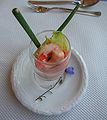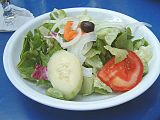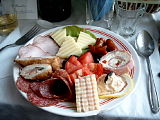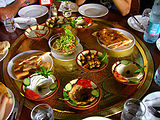- Hors d'oeuvre
-
"Appetizer" redirects here. For the dock application, see Appetizer (software).
Part of a series on Meals 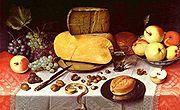
Common meals Breakfast · Brunch · Lunch · Tea · Dinner · Supper Components & courses Amuse-bouche · Appetizer · Cheese · Cocktails · Dessert · Drink · Entrée · Entremet · Fruit · Main course · Nuts · Salad · Side dish Related concepts Banquet · Buffet · Cuisine · Eating · Etiquette · Food · Global cuisines · Outline of cuisines · Snack Hors d'oeuvre (UK
 /ɔrˈdɜrv/ or /ɔrˈdɜrvr(ə)/,[1] US /ɔrˈdɜrv/; French: [ɔʁˈdœvʁ] (
/ɔrˈdɜrv/ or /ɔrˈdɜrvr(ə)/,[1] US /ɔrˈdɜrv/; French: [ɔʁˈdœvʁ] ( listen), literally "apart from the main work"), also known as appetizers, starters, or the first course, are food items served before the main courses of a meal.[2] The French (singular and plural) is hors d'œuvre; in English, the œ ligature is usually replaced by the digraph "oe" with the plural often written as "hors d'oeuvres" and pronounced /ɔrˈdɜrvz/. There are several related terms, such as a one-bite appetizer, as an amuse-bouche (or other terms below, under: See also).
listen), literally "apart from the main work"), also known as appetizers, starters, or the first course, are food items served before the main courses of a meal.[2] The French (singular and plural) is hors d'œuvre; in English, the œ ligature is usually replaced by the digraph "oe" with the plural often written as "hors d'oeuvres" and pronounced /ɔrˈdɜrvz/. There are several related terms, such as a one-bite appetizer, as an amuse-bouche (or other terms below, under: See also).Contents
Use
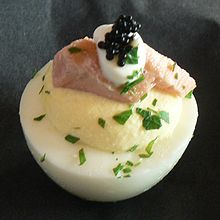 Deviled eggs are a cold hors d'œuvre
Deviled eggs are a cold hors d'œuvre Obložené chlebíčky, a Czechoslovakian appetizer or snack
Obložené chlebíčky, a Czechoslovakian appetizer or snack Canapé Sertanejo
Canapé Sertanejo
If there is an extended period between when guests arrive and when the meal is served (for example during a cocktail hour), these might also serve the purpose of sustaining guests during the wait, in the same way that aperitifs are served as a drink before meals. Hors d'oeuvre are sometimes served with no meal afterward. This is the case with many reception and cocktail party events.
Hors d'oeuvre may be served at the table, as a part of the sit-down meal, or they may be served before sitting at the table. Hors d'oeuvre prior to a meal are either stationary or passed. Stationary hors d'oeuvre are also referred to as "table hors d'oeuvre". Passed hors d'oeuvre are also referred to as "butler-style" or "butlered" hors d'oeuvre.
Though any food served prior to the main course is technically an hors d'oeuvre, the phrase is generally limited to individual items, not crudités, cheese or fruit. For example, a glazed fig topped with mascarpone and wrapped with prosciutto is considered an "hors d'oeuvre," whereas figs on a platter are not.
A more substantial starter or first course served at the table might be referred to as an entrée (outside the U.S. and English Canada).
Examples of Hors d'oeuvre include:
- Buffalo wings
- Canapés
- Caviar
- Cold cuts
- Crudités (raw vegetables used for dipping)
- Deviled eggs
- Cheeses
- Nachos
- Sausages
- Dumplings
- Bruschetta
- Cocktail wieners
- Tongue toast
Other languages and cultures
- Zakuski are hors d'oeuvre in Russian cuisines. Usually presented buffet style, it often consists of cured meats and fishes, various pickled vegetables such as beets, cucumbers, and garlic, prepared salads, caviar, and breads.
- In China, it is called lěng pán 冷盘 ("cold plate"), or qián cài 前菜 ("before dish") in Mandarin.
- Zensai (前菜 lit. before dish) is Japanese hors d'œuvre.
Gallery
-
Swiss cuisine (Schynige Platte)
See also
- Amuse-bouche
- Antipasto
- Banchan, Korean side dishes
- Cicchetti
- Dim sum
- Finger food
- Garnish
- Kujulpan
- Meze
- Picada
- Preprandial, a term sometimes used to refer to hors d'œuvre.
- Pu pu platter
- Smörgåsbord
- Sushi
- Tapas
References
- ^ Oxford Dictionaries
- ^ "hors d'oeuvre: Definition from". Answers.com. http://www.answers.com/topic/hors-d-oeuvre. Retrieved 2010-01-31.
External links
Categories:- Appetizers
- French words and phrases
- Garde manger
- French loanwords
Wikimedia Foundation. 2010.



